The brief conversation in the park was rather different from
many of the on-street discussions I have with New York City drivers.
“Hi there, how’s everything going?” the elderly man asked
me, with such enthusiasm it took me slightly unawares. “Good,” he replied when
I assured him things were going pretty well. “You have a good day.”
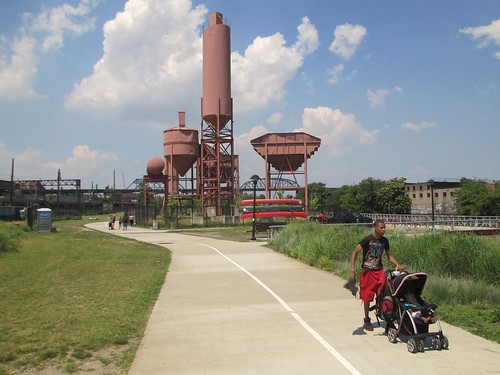 |
| Concrete Plant Park: a park that used to be a concrete plant - with older gentlemen speaking in Spanish |
Having wished him a good day in return, I pushed my bike
towards a bench, rummaged in my pannier bags and got out my lunchtime
sandwiches. I ate my lunch contemplating the scenery – if that’s not too
strong a word - of the Bronx
River.
The interchange in Concrete
Plant Park
was one of many joys of my bike ride this past Saturday almost all the way
across New York , from my home in Brooklyn, to City Island New England
fishing village strangely marooned in the city.
However, the aspects of the trip that stood out weren’t
those I’d been anticipating. I’d expected to explore New
York ’s relationship with the inlets of the sea, rivers and islands
that define the city’s unusual geography, confining high-rise Manhattan to one small island and allowing other parts of the city to sprawl.
I came back with a still more powerful sense of the city’s
remarkable atmosphere – of its people’s readiness to engage, their
straightforwardness and their sense of fun. My only regret is that the city
still hasn’t properly harnessed its people’s vigour and enthusiasm to a serious
effort to make its streets safer. That feeling is all the more intense because
I came on my way home on the aftermath of a car crash. While it seemed to have had no serious consequences, it could easily have killed someone.
I headed out partly because I was lonely, after my wife and children went to visit family in the UK , and because I wanted to regain
some fitness after being off my bike for two weeks in June with a broken foot.
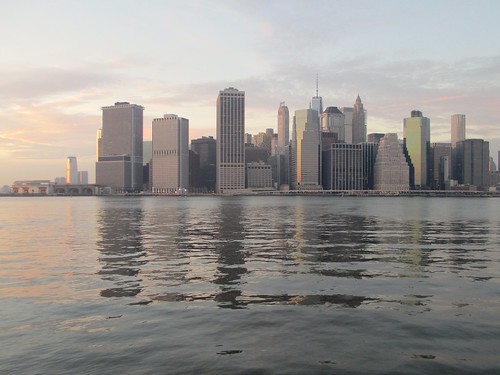 |
| Financial District skyscrapers, reflected in the East River: giraffes round a watering hole - or something. |
I planned my route to take in all the city’s boroughs,
except for Staten Island , and a series of different
land masses. I would start on Long Island, where I live, cross over onto Manhattan Island ,
then the twin, linked Randall's and Wards
Islands in the East
River . Then I’d cross onto the US
mainland in The Bronx and finally out onto City Island New York sound an appalling place when I
wrote about cycling here.
I had the idea for the route because I’m struck by how it’s
the areas where it’s impossible to build – the East River, the Hudson, New York
Harbour – that give the land in the city its sense of place. Some of the city’s
densest, highest-rise areas are crowded round the water, as if the buildings
were so many giraffes, crowding round a drinking hole. The meandering Thames
and the city’s other rivers and canals give parts of London a similar feeling. But there's nothing there quite as spectacular.
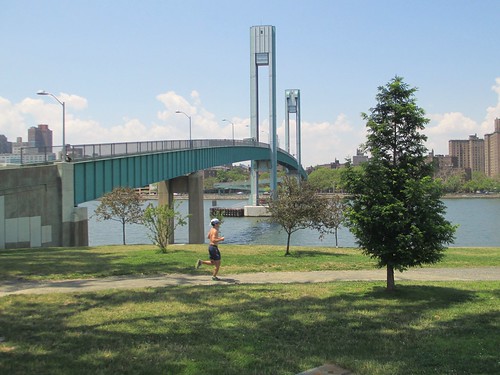 |
| The 103rd St bridge: drama - and a passing New Yorker too |
The moments of greatest drama were indeed bridges that swept
over key canals and inlets of the sea. The Pulaski Bridge carried me over
Newtown Creek from Brooklyn to Queens, with a dramatic view of midtown
Manhattan to my left; the Queensboro Bridge soared high above Roosevelt Island
in the East River; the graceful 103rd St foot and cycle bridge carried
me from Manhattan onto Wards Island, in the centre of Hell Gate at the junction
of the East River, Harlem River and Long Island Sound.
I was struck anew as I rode – but not surprised – by the
influence over the city of Robert Moses , the
powerful – unelected – official who shaped planning for New York City and state between 1924 and
1968. Moses was a passionate fan of open-water swimming, roads and parks. It
was unmistakeable how that trio of interests had led him to make particularly
wrenching changes to the bits of the city nearest the water. As I rode up by
the East River in Manhattan , I was pedalling at
one point on a promenade that Moses built above a section of East River Drive that he designed,
looking across towards Randall's and Wards
Islands , which he entirely reshaped,
and at his Tri-Borough
Bridge
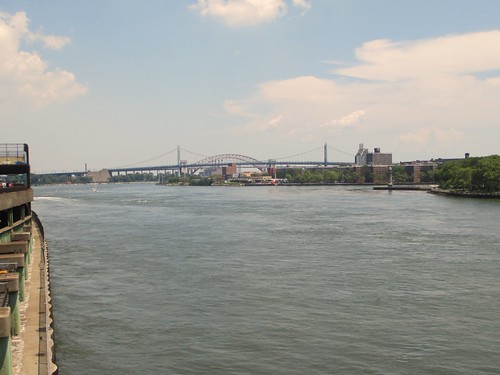 |
| East River Drive, Tri-Borough and Wards and Randalls Islands: Robert Moses' influence on the city, crowded round the East River |
But a different sensation started to creep over me. It began
with the driver in Cobble Hill who carefully waited for me to start when some
lights changed and I was stuck behind a car. “You goin’?” he asked politely,
before letting me move off. It continued with the man in Concrete Plant
Park Pelham
Parkway in The Bronx. He was an almost laughably
complete picture of how people would imagine a cyclist from the area that first
spawned rap should look. His baseball cap faced backwards and his BMX bike was so
tiny he had constantly to stand up. Yet he was looking, like me, to get
somewhere particular, as fast as he could.
“Orchard
Beach City
Island
I advised him to follow me.
Again and again as I rode, I was aware of how the city’s
people were working as hard on this hot, not-too-humid Saturday at enjoying
themselves as they would during the week at their jobs. As I returned home
through Concrete Plant Park
Other parks were full of the elaborate barbecue parties that
will be familiar to anyone who knows New
York . Moustachioed fathers were lugging big grills
into position while women fussed over coolers full of marinating meat. Sound
systems blared Latin music.
It was almost an anti-climax after immersing myself in the
vibrant, multi-ethnic atmosphere of The Bronx’s parks to ride over the bridge
onto City Island
The impression of New
York as a vast, crazy communal effort grew on me
still further as I headed home. I puzzled a group of young, African-American men just after I
left City Island
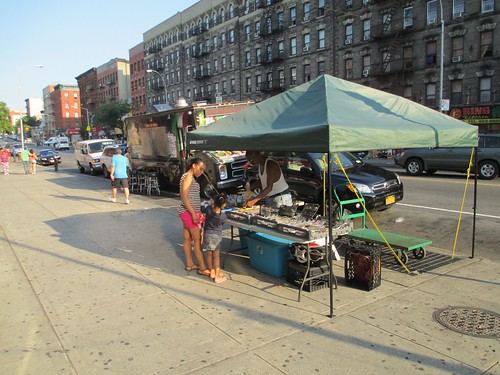 |
| The South Bronx: battered by Robert Moses, but unbowed |
The streets grew more and more crowded as I headed south and
the sun sank in the sky. In East Tremont in The
Bronx – an area where Robert Moses’ cross-Bronx expressway wreaked particular
social devastation – there were little knots of people out on the streets,
gathered round attractions whose significance I didn’t understand.
I was feeling, I realised, the flipside of the atmosphere in
New York that
makes drivers short-tempered and intolerant. Its being a hard and
uncompromising place to live, I began to feel, gave many of the city’s people a
directness and determination that felt life-enhancing and exciting to be around. New
York has a way of pummelling the timidity and shyness
out of one.
Yet, perhaps inevitably, I was to come across a reminder
that that frankness and directness don’t always mix well with being on the
roads. As I rode along the East River shore of northern Manhattan ,
I noticed an unusual number of emergency vehicles heading south on the adjoining
East River drive. Rounding a corner, I found a
group of them working to turn back upright an car overturned in the lanes
nearest the cycle path. “It just started turning over,” I heard the clearly
stunned – but thankfully not badly hurt – driver telling an ambulance crew.
“People think they can drive any speed and nothing will go
wrong,” I remarked to another onlooker, trying to put across a road safety
message.
He wasn’t ready to hear.
“Yeah,” he replied. “But to walk away from that –
impressive!”
It was a response that, under some circumstances, I could
have found depressing. It’s dispiriting that so many people focus when thinking
about their road behaviour on what they can walk away from, rather than what’s
rational for them and those around them. I could also have grown frustrated at
how many of the miles of waiting drivers I subsequently passed were leaning on
their horns, as if their frustration would make the emergency workers go
faster.
But, even as I rode past the honking vehicles, I was taking in
the different – but still positive – atmosphere of this far more prosperous part of the
city. People sat on benches looking over the East River watching the powerful
currents that tear through the area around the tip of Roosevelt
Island . Residents of the Upper East Side
wandered along the esplanade so calmly and contentedly in the setting sun that
it felt almost like riding through an idealised architect’s drawing of a
perfect urban scene. I noticed as I rode across the Queensboro Bridge
It was, in the end, a round-trip of 56 miles on a day when
temperatures reached nearly 30C. I arrived home hot, sweaty and feeling a keen
need for the Chinese food I’d put aside that morning.
But I’d worked at enjoying myself just as much as the
grill-lugging fathers I’d seen in the parks, and I came home feeling more
connection with the city’s alternately infuriating and endearing people than I’ve
ever felt before.
Perhaps, a voice inside me suggests, I am becoming a New
Yorker.


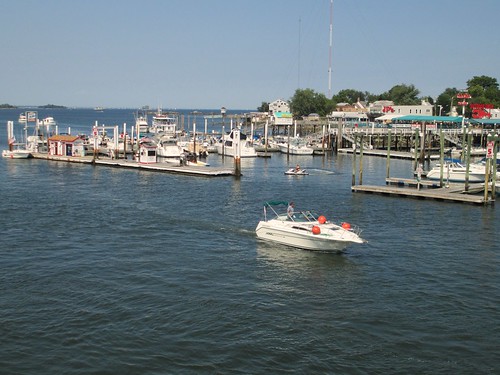


Lovely post, makes me very jealous.
ReplyDeleteMatthew,
DeleteThank you for your kind words.
Invisible.
It's sad that I think negative thoughts when I see "NYPD."
ReplyDeleteSteve,
DeleteI sometimes try to think of the NYPD as an elaborate, very dark joke at the city's expense. New York's finest? Courtesy Professionalism Respect? Hahahahahahahaha.
Then they come along and, for example, choke to death a guy whose crime, if he'd committed any at all, was to have sold some untaxed cigarettes and I realise it's actually not funny in any way at all.
All the best,
Invisible.
That shot of the East River Promenade is great, and a bit of New York that I've never sen pictures before.
ReplyDeleteThank you. I'll give the credit for the shot to the New York sunshine, which in late afternoon/early evening makes nearly everything look magical.
DeleteAll the best,
Invisible.
Did this ride memorial day 2013. Found City Island a bit of a letdown actually, full of drivers and no beach (only discovered the nice beach just to the east on Google maps after the trip).
ReplyDeleteChickenhom,
DeleteAs I suggested, the journey was more exciting as far as I was concerned than the arriving. City Island is fairly car-clogged. The nice beach, incidentally, is Orchard Beach, which my interlocutor in The Bronx was trying to find. It's a typical Robert Moses creation, made by taking two islands and joining them together.
But I'm always a little leery of taking my bike near a beach, anyway. Have you seen what sand does to derailleur gears?
All the best,
Invisible.